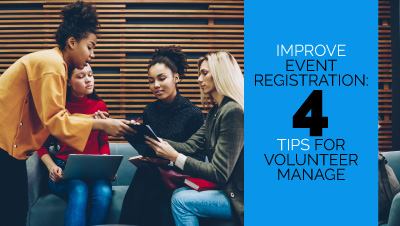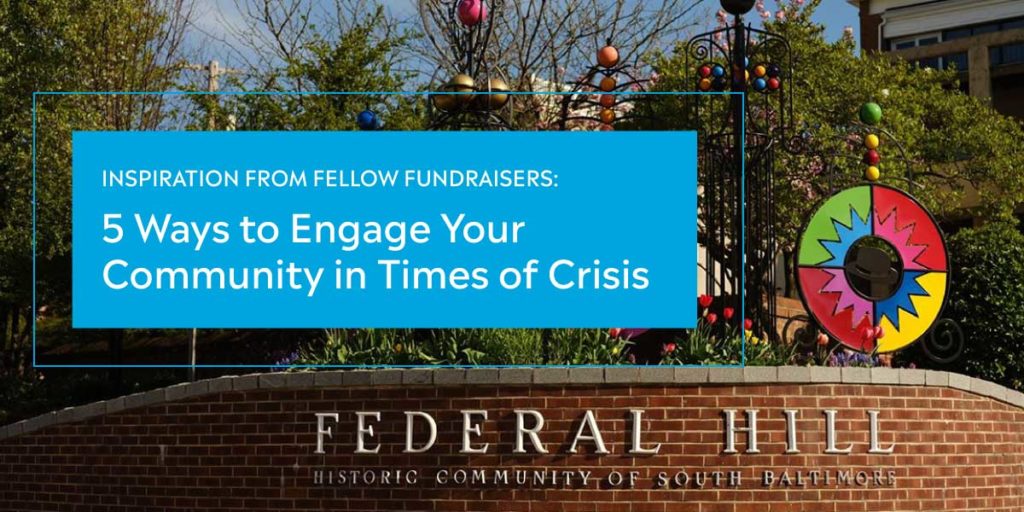Your volunteers keep your nonprofit running, but events often showcase just how vital volunteers can be. At virtual, in-person, and hybrid events, volunteers handle responsibilities that often go overlooked but can make all the difference in how your nonprofit’s supporters view your organization.
Event registration is one of those key components of effective event management that often goes unnoticed when done well but can leave a bad impression when done poorly. Guests who get caught in long lines or experience extensive waiting times likely start your event with negative feelings that can affect their entire experience.
Thankfully, with proper volunteer management, you can avoid this situation almost entirely. When armed with the right event registration software technology, your volunteers can improve your event registration process for your guests. The information collected from your registrations can also be used to inform how you manage your volunteers, creating a better experience that will encourage them to help out at your next event. To help your nonprofit make the most of both your registration software and your volunteers, this article will explore how to:
- Streamline Online Registration Processes
- Staff Volunteers at Registration Tables
- Volunteer Check-in
- Use Registrations to Organize Your Volunteer Approach
How you implement these tips will depend on your event’s size, your volunteers’ specific needs and skill sets, and whether your event is virtual, hybrid, or in-person. Consider your upcoming events and adapt these practices to meet challenges and rise to opportunities relevant to your situation. Let’s get started.
1. Streamline Online Registration Processes
Online registration for virtual events is often a two-step process. Guests first sign up on your website, then are formally checked in at the beginning of the event to gain access to your event. Both steps of this process can be streamlined to improve guest experience, and your volunteers can help.
Your registration software can carry over key information from your guests’ initial sign-ups on your website to your event software. Software that automatically syncs information from the initial sign-up stage to check-in at your event reduces data entry and allows volunteers to quickly access everything they need to get attendees registered quickly and efficiently.
For example, if you’re hosting an event at a campsite, National Park, or other location that requires a waiver, your volunteers will need to find specific waivers to confirm each guest has correctly signed the appropriate documents. With hundreds of guests (or even just large parties arriving at the same time), online waivers that require an online search dramatically outpace the speed of sorting through piles of paper waivers by hand.
Practices like the example above help guests get to your event faster, and they place less of a burden on your volunteers. Remember, while you’re trying to create a positive experience for your guests, you also need to create a positive experience for your volunteers.
Events that have unnecessary busywork or result in guests venting their frustrations to volunteers reduce the chances that your volunteers will want to come back for your next event.
2. Staff Volunteers at Registration Tables

No one likes long lines, especially at registration and check-in tables. If you’re hosting in a small event space, long lines not only frustrate guests trapped in them, but they also cause other guests to have to walk around them to reach other parts of your event.
Fortunately, you can prevent this problem with a simple solution: staff more volunteers at your registration tables. For smaller teams, consider staffing more of your volunteers at your registration tables during the beginning of your event when you’re likely to have the longest lines, then transition them away to other responsibilities once lines become more manageable.
However, it’s not enough to just sit your volunteers down at a table and tell them to start helping guests. You can create a more professional experience for your guests and help your volunteers feel prepared by:
- Holding a volunteer orientation. No matter what they’re doing at your event, all of your volunteers should attend an orientation before joining into your nonprofit’s activities. Orientations allow you to set expectations and outline basic responsibilities and practices that all volunteers should know when interacting with donors. If volunteers have questions, this is also an opportunity to answer those inquiries, identify potential holes in your volunteers’ knowledge, and find solutions before the event begins.
- Training volunteers how to use your software. If you need your volunteers to use your registration software, teach them how to use it. To streamline the process, you can create virtual training materials and check in with them afterwards to answer questions. Remember to explain both normal processes and warn them in advance of any technical issues that might occur to prevent potential panic later on.
- Stationing a supervisor nearby. Visible volunteer managers let your volunteers know that your nonprofit cares about their contributions, while also providing a lifeline if anything does go wrong. This is especially important when interacting with donors because any problems that arise need to be addressed both quickly and professionally. For example, if a volunteer can’t locate a guest’s information in your system, calling in a supervisor to smooth over the situation is always better than leaving a volunteer to struggle.
Remember to thank your volunteers for all of their hard work throughout your event. Retaining volunteers can lead to a sustainable base of reliable supporters you can call on in the future. Volunteers who have worked at multiple events will also be more familiar with your nonprofit and can help lend new volunteers a hand if your volunteer manager is preoccupied.
3. Volunteer Check-in
Like your guests, your volunteers need to be accounted for, too. Checking in your volunteers is more than just taking a headcount as it gives your volunteer managers an opportunity to review and keep track of everyone working with during the event.
As Regpack’s guide to virtual event registration explains, virtual registration software isn’t just for your attendees, but for your team as well, especially during virtual events. Volunteer managers need to have a way to stay in close contact with volunteers. The challenges presented by remote, virtual events can be overcome by starting your event with a personal check-in of every volunteer to make sure they’re ready and can easily get in touch with their supervisor.
Oftentimes, volunteers also need certain information tracked, such as their hours. Some volunteers need hours tracked in order to earn tax breaks or for other responsibilities that require a certain amount of volunteer time. However, your organization can also benefit from logging volunteer hours if your volunteers are eligible for volunteer grants.
Volunteer grants are donations made by your volunteers’ employers in response to their charitable work, making these grants essentially free money your organization can earn after your events.
While some corporations require volunteers to work a certain number of hours before becoming eligible for a volunteer grant, according to Double the Donation other companies offer grants per hour worked, meaning you can earn grants from all of your eligible volunteers after a single event. Record your volunteers’ hours, help them discover if they qualify, and provide any assistance they need for to fill out their grant applications.
4. Use Registrations to Organize Your Volunteer Approach
While some guests may first register when they arrive at your event, the majority will register ahead of time. Some events are even pre-registration only, requiring guests to sign-up by a certain date.
Collecting this information ahead of time allows your event planners to distribute and organize resources based on your expected number of attendees. Volunteer managers should also use this data to help determine how they’ll organize and prepare volunteers by considering:
- How many volunteers are needed. If you have more guests, you’ll need more volunteers to help run your event. This may seem rather obvious, but it becomes more complicated when hosting virtual and hybrid events. For example, at a hybrid event, registration data will inform you how many guests are attending virtually and in-person, requiring your volunteer manager to divide volunteers to adequately assist both groups.
- What training volunteers need to receive. While many details of your event should be decided before opening up registrations, headcounts can give your nonprofit a clearer understanding of your event’s scope. From there, volunteer managers can determine how many volunteers need to be trained on which tasks and plan accordingly.
- How volunteers want to contribute. Volunteers want to give, but they also want to help in a way that’s meaningful to them. Registration data can inform your nonprofit if you have the freedom to let volunteers pick and choose what activities they want to help with, or if you’ll need to take a more structured approach to ensure all aspects of the event are covered.
If your nonprofit or association has a membership program, you can collect even more specific data about your guests to help organize your volunteer approach. Some membership software allows organizations to send surveys to their members, meaning you can directly ask guests if they prefer a hands-on or hands-off approach for various activities. This will help inform your training strategies for volunteers. Guides like this one can help provide a starting point for understanding how to make the most of your membership software to support both your events and volunteer managers.
Your volunteers are one of your nonprofit’s most valuable support bases, and with proper management they can improve nearly every aspect of your events, starting with your registrations. Keep in touch with volunteers from check-in to check-out at your events, and always remember to say thank you afterwards!
About the Author: Asaf Darash

Asaf Darash, Founder and CEO of Regpack, has extensive experience as an entrepreneur and investor. Asaf has built 3 successful companies to date, all with an exit plan or that have stayed in profitability and are still functional. Asaf specializes in product development for the web, team building and in bringing a company from concept to an actualized unit that is profitable.









